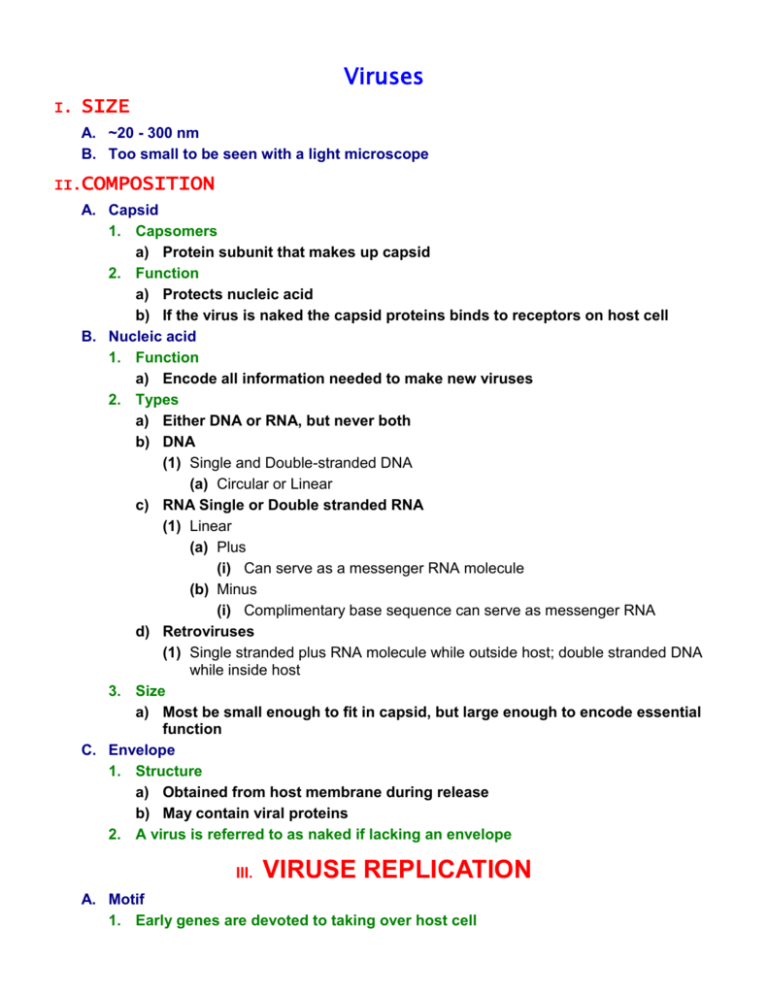B. Nucleic acid
advertisement

Viruses I. SIZE A. ~20 - 300 nm B. Too small to be seen with a light microscope II.COMPOSITION A. Capsid 1. Capsomers a) Protein subunit that makes up capsid 2. Function a) Protects nucleic acid b) If the virus is naked the capsid proteins binds to receptors on host cell B. Nucleic acid 1. Function a) Encode all information needed to make new viruses 2. Types a) Either DNA or RNA, but never both b) DNA (1) Single and Double-stranded DNA (a) Circular or Linear c) RNA Single or Double stranded RNA (1) Linear (a) Plus (i) Can serve as a messenger RNA molecule (b) Minus (i) Complimentary base sequence can serve as messenger RNA d) Retroviruses (1) Single stranded plus RNA molecule while outside host; double stranded DNA while inside host 3. Size a) Most be small enough to fit in capsid, but large enough to encode essential function C. Envelope 1. Structure a) Obtained from host membrane during release b) May contain viral proteins 2. A virus is referred to as naked if lacking an envelope III. VIRUSE REPLICATION A. Motif 1. Early genes are devoted to taking over host cell B. C. D. E. 2. Late genes are devoted to synthesizing viral DNA or RNA and capsomere proteins Steps 1. Adsorption 2. Penetration 3. Uncoating 4. Synthesis of viral proteins 5. Synthesis of viral nucleic acid 6. Assembly of virions 7. Release Attachment (adsorption) 1. Binding to specific sites on the surface of the virus to specific sites on surface of host cell 2. Receptors a) Usually a glycoprotein b) Normal part of a particular cell 3. Host a) cell in which a virus replicates Penetration 1. DNA only is injected into the host cell a) Bacteriophage and poliovirus enter host cells this way b) Simultaneous with uncoating 2. Fusion a) Viral envelope fuses with host membrane b) Found only in enveloped viruses 3. Endocytosis a) After endocytosis, the virus fuses with lysosome, which (low pH and host enzymes) initiates uncoating Viral protein and nucleic acid synthesis 1. Protein synthesis a) Uses host ribosomes, ATP, amino acids, tRNA, etc. b) Function of viral proteins (1) Alter host cell functions (a) Decrease host nucleic acid synthesis and degradation of host nucleic acids (i) This increases resources available to make new viruses (2) Viral capsomere proteins (3) Enzymes for genome replication (a) Many viruses can use host enzymes to synthesize their genomes 2. Double stranded DNA viruses a) Replication, transcription and translation performed by host enzymes b) Similar to transcription and translation as with host DNA 3. Positive single stranded RNA viruses a) Genome serves as a giant mRNA (1) Host ribosomes will translate it to make viral proteins b) Viral-encoded RNA-dependent RNA polymerase will make a complimentary minus strand of RNA (1) The minus strand is used as a template to synthesize plus RNA molecules for new viral genomes 4. Negative single stranded RNA viruses a) Viral encoded RNA-dependent RNA polymerase synthesizes plus strand RNA (1) The plus strand is used for translation of viral proteins using host ribosomes (2) The plus strand also serves as a template for synthesis of minus strand RNA for new viral genome 5. Retroviruses (e.g., Human Immunodeficiency Virus) a) Viral encoded reverse transcriptase synthesizes a negative DNA strand (1) This enzymatic activity of reverse transcriptase is referred to as RNAdependent DNA polymerase activity b) Reverse transcriptase degrades positive RNA bound to the negative DNA (1) This enzymatic activity is referred to as ribonuclease activity c) Reverse transcriptase than copies negative DNA to form positive DNA (1) This is referred to as DNA-dependent DNA polymerase activity d) Proviral DNA than integrates into chromosome (1) This is catalyzed by HIV-encoded integrase e) The DNA strand is transcribed into mRNA for protein synthesis or for new viral genome (1) This uses host RNA polymerases and ribosomes F. Assembly 1. Late genes direct synthesis of capsid proteins which self assemble 2. Nucleic acid is then inserted into the empty procapsid a) Mechanisms unknown G. Virion release 1. Naked a) Usually lyse host cell 2. Enveloped a) Viral encoded proteins inserted into cytoplasmic membrane and then the virus 'blebs' out






